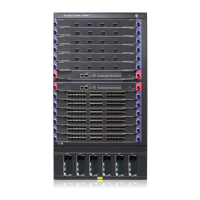103
Ste
Command
Remarks
2. Enter the interface view of an
MPLS TE tunnel.
interface tunnel tunnel-number N/A
3. Configure the tunnel to use
static CR-LSP.
mpls te signal-protocol static N/A
4. Submit the current tunnel
configuration.
mpls te commit N/A
5. Return to system view.
quit N/A
6. Create a static CR-LSP.
• On the ingress node:
static-cr-lsp ingress tunnel-name
destination dest-addr nexthop
next-hop-addr out-label
out-label-value
• On a transit node:
static-cr-lsp transit tunnel-name
incoming-interface interface-type
interface-number in-label
in-label-value nexthop
next-hop-addr out-label
out-label-value
• On the egress node:
static-cr-lsp egress tunnel-name
incoming-interface interface-type
interface-number in-label
in-label-value
Follow the guidelines to
correctly configure the
ingress, transit, and egress
node.
Configuring an MPLS TE tunnel with a dynamic
signaling protocol
Dynamic signaling protocol can adapt the path of a TE tunnel to network changes and implement
redundancy, FRR, and other advanced features.
The following describes how to create an MPLS TE tunnel with a dynamic signaling protocol:
• Configure MPLS TE properties for links and advertise them through IGP TE extension to form a TEDB.
• Configure tunnel constraints.
• Use the CSPF algorithm to calculate a preferred path based on the TEDB and tunnel constraints.
• Establish the path by using the signaling protocol RSVP-TE.
To form a TEDB, configure the IGP TE extension for the nodes on the network to send TE LSAs. If the IGP
TE extension is not configured, the CR-LSP is created based on IGP routing rather than computed by
CSPF.
Configuration prerequisites
Before you perform the configuration, complete the following tasks:
• Configure static routing or an IGP protocol to make sure all LSRs can reach each other.
• Configure basic MPLS.

